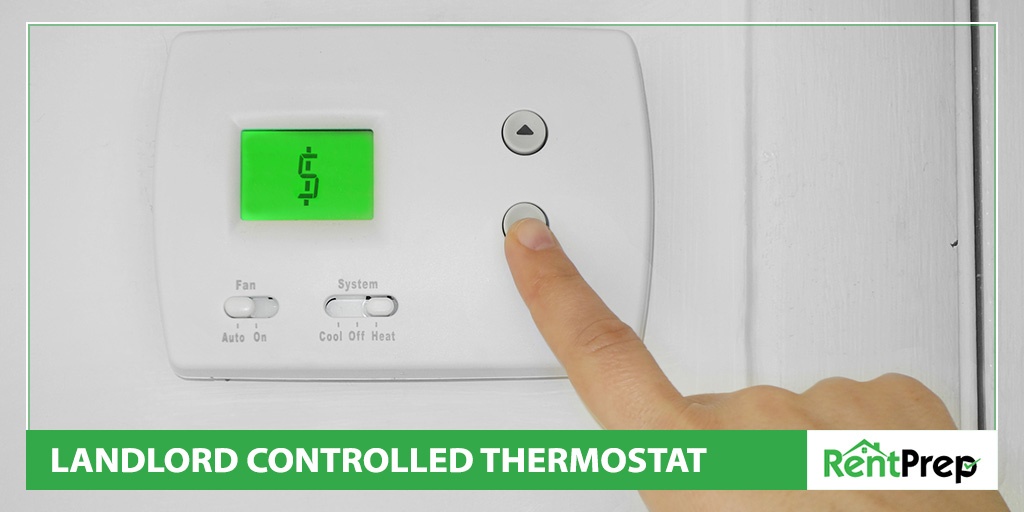
Managing utilities in your properties can be a daunting task. When the properties are rented, you need to be sure the tenants are following the lease agreement and keeping the temperatures above the minimum. When the properties are vacant, you want to be sure the property is being properly heated and cooled to prevent any damage to the unit.
The only way to be sure the temperature in your property is kept in the right zone even when you cannot be at the property is to set the unit up with a landlord controlled thermostat that you can access remotely or pre-program.
Of course, there are imitations, rules, and basic etiquette you need to think about when having a tenant thermostat that you have access to, but choosing the right smart thermostat can make those considerations simpler than ever before.
Let’s take a closer look at the top three thermostat options as well as some important notes to consider when you are installing a thermostat you can access and control on-the-go.
A Table Of Contents For Tenant Thermostat Options
- Top 3 Thermostat Options
- Why You Want A Landlord Controlled Thermostat
- Including Appropriate Lease Clauses
- Pay Attention To Local & State Laws
Top 3 Thermostat Options
If you are ready to install a thermostat you can control in your properties, there are many different types of thermostats you will need to search through in order to find the right fit. Generally, the top-of-the-line thermostats that have the most efficient and capable functionalities today are smart thermostats, so those make up a large part of our top choices.
As a landlord, you are responsible for many things in the property. Ensuring that heating and cooling are properly controlled is one of them.
Let’s take a closer look at the top three options that landlords prefer in today’s market.
#1: Honeywell Home Wi-Fi 7-Day Programmable Thermostat
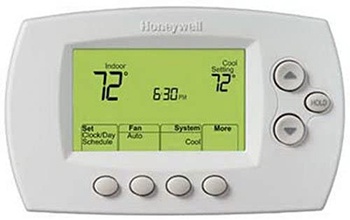 This programmable home thermostat is made by the well-known and reliable heating and cooling part company Honeywell. Honeywell is a name that many in the home-owning and management sectors will be familiar with, so it’s great to get started with something that you already know.
This programmable home thermostat is made by the well-known and reliable heating and cooling part company Honeywell. Honeywell is a name that many in the home-owning and management sectors will be familiar with, so it’s great to get started with something that you already know.
Honeywell’s Home 7-Day Programmable Thermostat gives you and/or your tenants the opportunity to be connected to the thermostat even when you aren’t standing directly in front of it thanks to the included online capabilities. The thermostat is connected to the home’s Wi-Fi network, and then you can connect to the thermostat through the app.
By downloading a simple app, you can easily check on the heating and cooling systems as well as make adjustments to the programming when you won’t be able to come home and adjust them directly. The app can also be used in conjunction with popular smart home brands like IFTTT, Samsung SmartThings, Amazon Alex, and Google Assistant.
This thermostat also has smart technology, which can help to estimate your tenant’s schedules and maximize efficiency based on how the property is being used. The system also has some of the more traditional features such as day-to-day programming, temporary hold periods, and easy-to-navigate temperature control on the box itself.
What Landlords Like
- Can be checked and controlled from anywhere
- Helps to maximize heating/cooling efficiency
- Enhanced control helps optimize costs
- Can set up both temporary and permanent hold cycles in a property
What Landlords Don’t Like
- Doesn’t work with some heating systems, such as electric baseboards
- Limited voltage range that it can be used with; must check your circuits
#2: Nest 3rd Generation Learning Thermostat
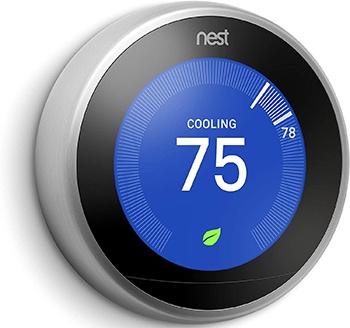 Google Nest is quickly becoming well-known as one of the best smart home solutions, and many landlords are considering adding this type of thermostat to their homes because of the smarter technology it employs when compared to other options currently on the market.
Google Nest is quickly becoming well-known as one of the best smart home solutions, and many landlords are considering adding this type of thermostat to their homes because of the smarter technology it employs when compared to other options currently on the market.
This thermostat, made by Google for their Nest smart home program, can be used in conjunction with any Amazon Alexa devices you or your tenant might be using, which makes it very simple to control when you are in the home.
Additionally, it can be controlled remotely on your phone, computer, or tablet device. This is great for landlords who want to be able to make sure their properties are in home/away states when unrented or when their tenants are going out-of-town.
Nest has a very unique auto-scheduling system that is self-taught. As your tenant adjusts the temperature at various points throughout the day, the system will learn what temperature is preferred and adjust its schedule for the highest levels of comfort and efficiency possible.
This thermostat can be purchased with a Wi-Fi and extra sensor if you want to expand the reach of the device or the areas it uses to turn the system on and off. This can be very helpful if your property has multiple rooms that heat at different speeds or a Wi-Fi system that doesn’t quite reach where you would like to install the Nest thermostat.
What Landlords Like:
- Can check energy history to learn more about usage
- Smart thermostat self-adjusts for better efficiency
- Visual queues on the screen help tenants be more eco-friendly
- Can be controlled remotely
What Landlords Don’t Like:
- Not truly programmable, so hard to set specific schedules
- Auto-schedule feature doesn’t always make sense for rentals and can be hard to make tenants understand how it works
#3: Emerson Sensi Touch Wi-Fi Smart Thermostat ST75
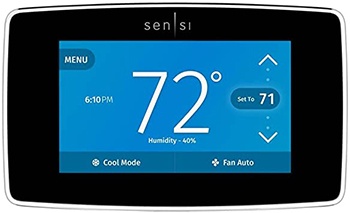 Finally, get to know the Emerson Sensi Touch Wi-Fi Smart Thermostat to see if it is going to be the right fit for your future tenant thermostats. Sensi is a smart thermostat designed by Emerson to be one of the easiest on the market to install even if you have no previous experience with thermostats and heating/cooling systems.
Finally, get to know the Emerson Sensi Touch Wi-Fi Smart Thermostat to see if it is going to be the right fit for your future tenant thermostats. Sensi is a smart thermostat designed by Emerson to be one of the easiest on the market to install even if you have no previous experience with thermostats and heating/cooling systems.
The Sensi app, which can be used to control the thermostat once it is installed, can also be used to assist in the installation process. The app will guide you through disconnecting your old thermostat and connecting the new one, which makes it easy for most people to get hooked up in 30 minutes or less.
The app is useful for more than just installation; it also becomes a very powerful tool for managing the thermostat. Whether you want to have remote control to the thermostat or set your tenants up on the smart system, using the app can make it easier to use the energy at the property efficiently.
There are two primary ways to set up the scheduling with this system, and both can be useful for landlords depending on your rental and utility setup. First, you can set up geofencing for your tenants on their smartphone so the system will go into reduced modes when they are away from home.
Alternatively, you or the tenant can set up programmed, flexible scheduling for every day of the week. Both of these scheduling and management systems are easy to set up thanks to the tools provided by Emerson.
What Landlords Like:
- Easy to understand app for control and installation
- Useful usage guides to create better usage habits
- Can be controlled remotely
- Can set up smart alerts for any temperature range notifications
What Landlords Don’t Like:
- Not compatible with all systems
- App is required to do any type of scheduling
- Needs to be hooked up to 5-wire system; can be hard to install if that isn’t already in place for the unit’s current thermostat
Why You Want A Landlord Controlled Thermostat
Many landlords have not thought much about the thermostats in their properties. If the thermostats are functioning and easy to use, there isn’t much more to think about, right?
Yes and no. Ultimately, it is up to you as a landlord to decide if using a smart thermostat that you can access and control from outside of the unit makes sense for your property’s needs. The type of property you own may also play a factor. Single-family home temperatures tend to be controlled by the tenants while multi-unit buildings may have a building-wide system.
There are, of course, some benefits to having a landlord controlled system installed that you might want to consider.
Ensure Vacancies Don’t Cause Problems
Having a system you can access and control when you are not at the property can be very useful when you have vacant units. Not only can you reduce how frequently the heating and cooling systems run to ensure you aren’t going over budget, but you can also set the unit to warm up or cool down as needed before you bring any potential renters to the unit.
Additionally, you can set up alerts that will warn you if something is not working properly. For example, a smart thermostat may alert you when temperatures in the unit drop below 50 degrees Fahrenheit to ensure you are aware and can prevent any problems with your pipes freezing.
Having remote access to this part of your unit can make it much easier to manage even when you are away, and that can be a big stress reliever.
Prevent Temperature Dips
Another benefit that was briefly mentioned above is the ability to ensure the temperature at the property never falls outside of an expected range. If you live in an area where temperatures get dangerously low or could cause pipes to freeze, keeping the heat running to a small degree is a requirement.
Having a thermostat system you can monitor and control remotely allows you to make sure the unit is not damaged by falling temperatures even when they come unexpectedly.
Control Utility Costs
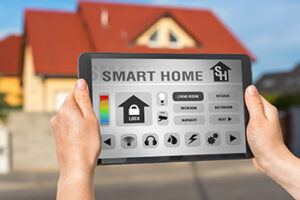
When managing rental units that include utilities in the rental cost, it can be very hard to balance that aspect of your budget if tenants are leaving their heating or cooling system running at all hours. Having a smart thermostat allows you to set up the general parameters for heating and cooling to better manage the cost.
While tenants will still be able to make some changes to the system, the default will be the temperatures you control, and that can make a big difference in the final utility costs associated with controlling the temperature of the property.
Including Appropriate Lease Clauses
It’s important your lease contains the right clauses in reference to thermostats and temperature control to prevent any issues between you and your tenant. This is particularly important in shared-system units and in units located in areas with very low or high temperatures.
It is recommended your clause states something along the lines of: “Deviation from the accepted range of xx degrees to xx degrees will result in a fine.” By clearly stating the rules and how that will be maintained, your tenant will be less likely to try to change the schedule on the thermostat without talking to you first.
Pay Attention To Local & State Laws
One huge caveat you must pay attention to when setting up your plan for controlling heating and cooling, whether you want to do that remotely or not, is that there may be local or state laws that impact your involvement.
While it might seem like a great idea to change the temperature whenever you want to, this can be a violation of your tenants’ rights. Even if utilities are included in the rent, your tenant has some rights to be able to control the temperature.
Be sure that any landlord controlled system you use allows for reasonable tenant input and that you are not intruding on their at-home experience while using it. Clearing up how this will work in the lease and ensuring you understand any local laws that may affect temperature control will help prevent any issues.
Keep A Watchful Eye
It’s okay to want to keep a watchful eye on your property, but remember to be reasonable about the level of involvement. Depending on the property type, it might be OK to totally control the temperature. This is especially true in multi-unit buildings with shared systems. On the flip side, single-family homes are best left to the tenants to maintain the temperature.
No matter how you choose to manage the day-to-day temperature control when a unit is rented out, remember that having a landlord controlled system is ideal for managing vacancy periods. Any of these top three options are landlord favorites; choose which suits your property the best!

